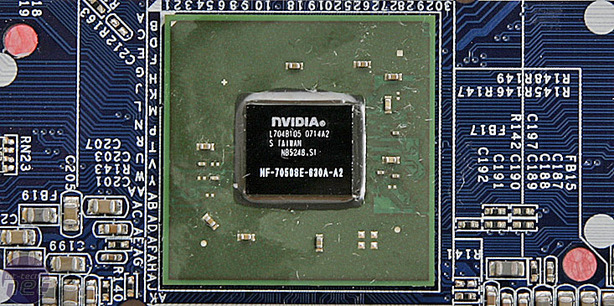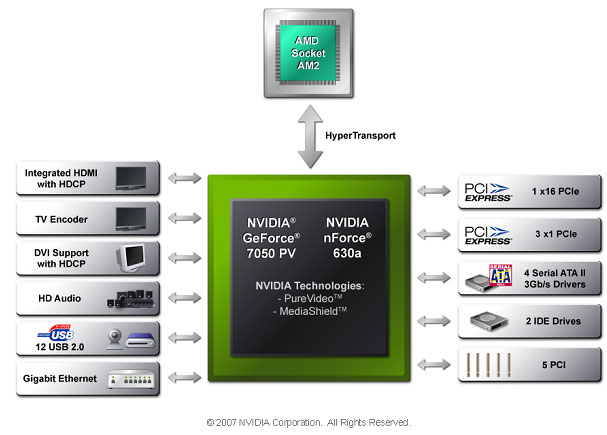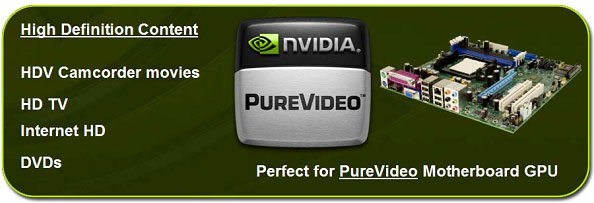Aye Gee Pea?
The Nvidia 7025 and 7050PV series integrated graphics chipset is the Jolly Green Giant's response to AMD's successful RS690 chipset. It might still be using the same graphics core as the GeForce 6150 chipset, however it does include an updated video processing engine and southbridge integrated into a single chip.Intel's G965 chipset has recently had a BIOS update to enable hardware functions for DirectX 9 capabilities in certain games. Additionally, Intel's updated G35 chipset is right around the corner so it's not as if the IGP market is non-existent as a result of all the graphical horsepower you get on today's discrete graphics cards. The reason why Intel has such a massive share of the graphics market is because of its IGP products used by OEMs world wide, so it should be inevitable that AMD and Nvidia want to get in on the action.
Nvidia GeForce 7050 Chipset
Nvidia's GeForce 7050PV chipset includes a dedicated Video Processing Engine especially for High-Definition video - this is known as PureVideo and it's a technology that most bit-tech readers should be reasonably familiar with.PureVideo supports hardware accelerated MPEG, VC-1 and WMV9 video decoding for greater energy efficiency (or, longer battery life where notebooks are concerned), as it helps to reduce CPU utilisation while watching movies. Of course, there are various MPEG formats - Nvidia specifies hardware-accelerated MPEG-2 at resolutions up to 1080i and h.264 (MPEG-4 AVC) decoding at up to 720p.

In addition, there are post processing features like Motion Adaptive De-interlacing, High Quality video scaling with improved inverse telecine algorithms like 2:2 and 3:2 pull-down correction. There is also support for Microsoft Video Mixing Renderer (VMR) for multiple, independent video playbacks at full quality and definition. The chipset sports a 16-way VLIW (very long instruction width) SIMD vector processor specifically designed for video processing, that can process up to 96 operations per clock.
Both of the chipsets support native HDCP but only the 7050PV integrates HDMI 1.2 on-board. Seeing as there’s no decoder or receiver that can work with Dolby TrueHD or DTS Master HD audio over a digital connection and the fact that Windows itself is still limited to just 24-bit colour (+8-bit alpha = “32-bit”) with no support for 36-bit colour (Deep Colour) on the horizon, HDMI 1.3 support is fairly pointless at the moment.
The GeForce 7050PV chipset also includes native TV out support as well, meaning you can also use either composite, S-video or component outputs. This gives the 7050PV chipset a competitive feature set compared to AMD's 690G, and makes it a potential HTPC chipset of choice.

Although both the 7050PV and 7025 chipsets are single chip solutions, Nvidia uses the same silicon for the "southbridge" portion of the chip - this is known as nForce 630a. For the sake of terminology, we'll refer to nForce 630a as the "southbridge", but please bear in mind that it is on the same silicon as the graphics core.
nForce 630a is a small update to the nForce 430 southbridge previously used in conjunction with the GeForce 6150 integrated graphics core. It includes the same number of SATA ports and has the same RAID 0, 1, 0+1 and 5 support. Additionally, there is still only the one Gigabit Ethernet controller too. The chipset does however support one more PCI-Express x1 lane and two more USB 2.0 ports bringing the maximum up to twelve.
The integrated graphics core is still just DirectX 9 compliant with Shader Model 3.0 capabilities, but Nvidia was quick to stress that the chipset is not intended for anything remotely graphically intensive, despite now bearing the GeForce branding. Labelling it a GeForce rather than a nForce is meant to signify that Nvidia considers it a complement to its graphics card range in functionality and use of drivers. The IGP actually uses independent drivers for the graphical portion and the southbridge, even though it’s physically just a single chip.
The IGP uses a 425MHz core clock with two pipelines, two pixel shaders, two texture units and one vertex shader so it’s a long way from any sort of graphical colossus. It does support HDR, however you’re still limited to using that OR anti-aliasing... not that we think it’s really able to run either fast enough though.

Interestingly, Nvidia doesn’t state that the chipset is capable of full 1080p HD DVD or Blu-ray playback and states that a 500MHz core clock is needed to achieve this. We've checked to confirm and Nvidia limits this in the drivers rather than even attempting to playback 1080p content. Because the LCD HDTV we've currently got in the office is limited to 50 or 60Hz minimum, even selecting "1080i" in the Nvidia driver settings didn't allow playback, we had to drop it all the way to 720p before we got an HD DVD to work in PowerDVD 7 Ultra.

In all, it’s a shame Nvidia didn’t increase the clock speed on the GeForce 7050PV chipset to allow it to play back 1080p HD content, but it certainly still offers a really capable passively cooled chipset that has a ton of features and connectivity options. There’s still no Intel version of the chipset available with a memory controller built in, but to be honest, with the 45W AMD Athlon X2 BE-2350s at the price they are, you’d be mad to insist on an Intel system unless you already have a processor spare.
The memory controller on the chipset is likely to make it hotter requiring either a fan, which is a big no-no for a quiet HTPC system, or alternatively the engineers might use a large heatsink that takes up a lot of real estate on a small mATX motherboard.
Considering AMD has just released an update of its 690G chipset to allow a simple BIOS flash to overclock the IGP, which results in support for full 1080p HD playback, it'll be interesting to see how Nvidia reacts. Will the company do the same and catch up? Perhaps not, considering the very small push this chipset has had. After all, Nvidia is gaining market share hand over fist on its nForce 680 and 650 lines and the 7025/7050PV chipset is still Vista Premium capable so should still suit OEMs and ODMs.

MSI MPG Velox 100R Chassis Review
October 14 2021 | 15:04










Want to comment? Please log in.